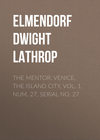Loe raamatut: «The Mentor: Venice, the Island City, Vol. 1, Num. 27, Serial No. 27»
VENICE, THE ISLAND CITY
ST. MARK’S CATHEDRAL
DOGE’S PALACE AND CAMPANILE
BRIDGE OF SIGHS
GRAND CANAL
TYPICAL VENETIAN CANAL
RIALTO BRIDGE
A Trip Around the World with
DWIGHT L. ELMENDORF, Lecturer and Traveler
“The Pearl of the Adriatic,” she has been called. “Queen of the Sea” is another of the poetic terms applied to her. If all the expressions that have been used by admirers to pay tribute to the beauty of Venice were gathered together, they would make a glossary of eulogy of considerable size. It was inevitable from the beginning that Venice should receive such homage; for she has a beauty that distinguishes her from all other cities. She is absolutely unique in picturesque attraction and in romantic interest. There are many cities that draw the admiration of the traveler: there is but one Venice, and anyone who has been there and felt her spell cannot wonder at the worshipful admiration that she has received from the time of her birth in the sea.
The fascination of Venice for the traveler is such that ordinary terms of appreciation are insufficient. The city takes complete possession of one, and visitors who have surrendered to her charms are referred to as having the “Venice fever.” All who love beauty have had more or less violent attacks – the artist is most susceptible to it.
HOW IT CAME TO BE
Venice is built on a group of little islands. At a depth of from ten to fifteen feet there is a firm bed of clay; below that a bed of sand or gravel, and then a layer of peat. Artesian wells dug to the depth of sixteen hundred feet have shown a regular succession of these beds. On this base, piles, where they have been used for the foundation, have become petrified. So the city may be described actually as having been built up from the bed of the sea. In its physical aspect it may be summed up by saying that Venice stands on 117 small islands formed by something like 150 canals and joined together by 378 bridges.
There is but little in the way of sidewalks. Occasional narrow paths of stone skirt the canals; but in many places the water laps the very walls of the buildings, and transportation is to be had only by boat. Of course there are many lanes and passages among the houses; but the general effect is such as would make an impression on the traveler of a city set in the sea, and the people live, move, and have their being on either stone or water. They are strangers to groves, shady lanes, and country places. Some of the inhabitants of Venice have never seen a horse or a cow.
The city is divided into two parts by the Grand Canal, which is nearly two miles in length and varies from 100 to 200 feet in width. It makes a fine curve like the letter S, and by this it displays to advantage the magnificent residences that line it. There on its gleaming surface are to be seen the brilliant pageants of the city, – gondolas and autoboats in great number, gay parties, chatting and laughing and tossing flowers, and the whole stretch a blaze of intoxicating color. Some of the most attractive views of Venice are to be had not from within the canal, but from some point out in the lagoon. Your map of Venice will show you the city not literally situated in the Adriatic Sea, but located within the lagoon and protected from the outer sea by long sand hills strengthened by bulwarks of masonry. From the strip to the mainland, across the lagoon, where Venice is situated, the distance is about five miles, and in this stretch of water you will see many striped posts called “pali.” These mark the navigable channels about the city.
ST. MARK’S
It is not the physical conditions alone that make Venice unique. In the beauty and interest of its domestic architecture it ranks before any city in the world. The mosaics of Venice have been famous for centuries, and are today the marvel of all who see them. The spot where Venice has massed the gems of her beauty is St. Mark’s Place.
The view of Venice most familiar to stay-at-home bodies is the one to be had from across the water looking at St. Mark’s Place, and including, besides the cathedral of St. Mark, the Doge’s (doje) Palace and Campanile (cam-pa-nee´-le) Tower, and in some cases a glimpse of the Bridge of Sighs. The Piazza of St. Mark is called the “Heart of Venice.” All the life of the city surges there at certain times, then sweeps from there through its various channels. It is gayest on summer evenings, when the population turns out to enjoy the fresh air and listen to the military band. At that time the piazza is brilliant with fashionable people. Go there on a moonlight night, and you will find it a dream of beauty. You must see, of course, the pigeons of St. Mark’s. Flocks of them circle about the square or gather in groups on the pavement, wherever food is to be found. The pigeons of St. Mark’s used to be fed at public expense. It is not necessary now: there are always plenty of travelers that will pay them this pleasant toll for the sake of being photographed in their company. St. Mark’s Place is 191 yards in length, and in width 61 yards on one side and 90 on the other. The beautiful effect of it can hardly be expressed. It is paved with trachyte and marble, and surrounded by buildings that are not only important historically but most interesting architecturally.
The Church of St. Mark, now a cathedral, was begun in 830. The year before that the bones of St. Mark, the saint of Venice, were brought from Alexandria, and they now lie buried in the church. This marvelous building is Romanesque in style. During the eleventh and twelfth centuries it was remodeled and decorated with most lavish magnificence. In the fifteenth century it received some Gothic additions which enhanced its effect. In such short space as this it is impossible to do justice to the beauty of St. Mark’s. It is best by far to rest on what Ruskin has said in his “Stones of Venice”:


![Stones of Venice [introductions]](https://cdn.litres.ru/pub/c/cover_100/34843654.jpg)






